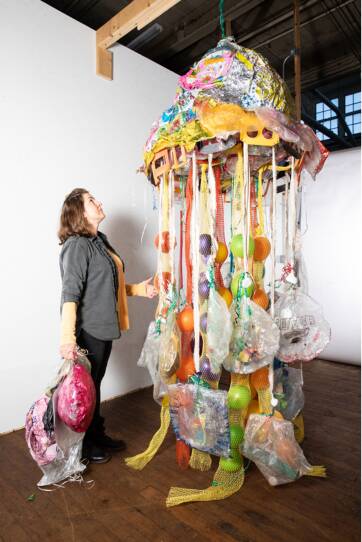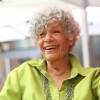A new MassINC/Boston Globe poll finds that Massachusetts residents are concerned about climate change, but fewer than half of residents list it as a high priority. Climate change trails behind concerns about health care, jobs, the economy, education, taxes and the cost of fuel.
Jane Winchell of the Peabody Essex Museum said many people feel overwhelmed by the issue. She understands why those people opt to disengage with the numbers, statistics, charts and mounting evidence — from more heatwaves to an increase in coastal flooding — that a global crisis is unfolding. But she sees her role as a way to get people to reengage.
“We're being barraged ... with information,” said Winchell. “And the art provides a way of connecting with it at the human level, at the personal level, at the emotional level.”
Winchell is the Sarah Fraser Robbins director of the Dotty Brown Art Nature Center at PEM. She also leads the museum’s Climate + Environment Initiative, and is currently curating exhibits that will educate visitors and inspire climate action.
“What are the exhibitions, what are the objects, the works of art, that will touch people?” Winchell said. “That they will feel something. And not in the way that you feel when you're looking at a graph on a wall, or hearing a science report. It's just a very different kind of experience, and that's why I feel like it's really important.”
In celebration of Earth Day, we're assembling our own exhibition, featuring five artists from the Greater Boston area who are working to address climate change through their work.
Yuko Oda: Exploring the beauty of nature and its destruction by human activity
Yuko Oda is a mixed media artist whose work includes mediums of animation, drawing and sculpture. Much of her work exists at the intersection of fine art and technology, combining techniques like 3-D printing and Nihonga, which is the traditional form of Japanese painting. Her pieces explore the beauty of the natural word, as well as its fragility.

In her work, Oda often fuses natural objects like tree roots, rocks and soil with synthetic materials like 3- D printed plastic sculptures.
“I find bringing together those two very different materials — almost opposite materials — as really a response to what's happening to our environment and the world around us,” said Oda. “Because if you look inside our soil, it's actually infiltrated and mixed up with some of the human-engineered elements and human byproducts, such as plastic garbage. And so I feel like I'm depicting a slice, or a moment, of what's happening to our environment right now.”
Oda grew up in Japan, where she was exposed to traditional artforms such as kimonos and watercolor paintings. She said while she appreciates those traditional artforms, she could "never" follow all the cultural rules surrounding them.
"I love having the Japanese traditional influence, but then kind of pushing against the norms to create something new and unique and kind of a new energy into what would otherwise be very unchanged, traditional aesthetics," she said.
Queen Allotey-Pappoe: Crafting slow fashion and wearable art inspired by her African heritage

When Queen Allotey-Pappoe first moved to Boston, she often found herself sitting in boardrooms and work meetings with other women who only wore clothes that were beige, black and gray.
“Growing up in Ghana, I used to see the market women in their very vibrant attire working very hard in the hot sun. And that scene has always stuck with me,” said Queen Allotey-Pappoe. “I made a mental note to myself that I was definitely going to have a brand that was going to inspire people to be more colorful and to just express themselves.”
As she embarked on the journey to create her fashion brand, Queen Adeline, she quickly discovered that the environmental, social and economic impacts of the fashion industry are more devastating than many people realize. According to the United Nations, the fashion industry contributes to around 10% of global greenhouse gas emissions and it consumes more energy than the aviation and shipping industry combined. To not add to this problem, Queen Allotey-Pappoe decided to place sustainability at the core of her business.

“I wanted to create a brand that not only empowered women and people in general, because I do create for other men and children as well,” said Queen Allotey-Pappoe, "but I also wanted it to be one that made people more conscious about the impact of their fashion choices and to offer a solution.”
Rather than following fast fashion trends, Queen Allotey-Pappoe designs her clothes to be seasonless and timeless. For example, one of her signature designs is a light, summery shirt dress that can transition to a winter layer in colder months. To reduce waste, she uses leftover fabric from her clothing designs to create accessory pieces like earrings and purses.
I always tell people that sustainability is a journey,” said Queen Allotey-Pappoe. “You will never come to that destination because it's always one step more to do. And so it's about the conscious intent of helping to reduce your impact.
Adriana G. Prat: Building a sustainable art practice one cardboard canvas at a time
Adriana Prat holds a PhD in biophysics and worked as a scientist before she became a full-time artist. Based in Cambridge, Prat creates her abstract paintings on upcycled canvases like cardboard, old vinyl records and coffee bags. She’s often asked if she worries her work won’t last as long as it would on traditional canvas.

“So I always refer, for example, to ‘The Scream,’ … by [Edvard] Munch,” said Prat. “It's made on cardboard. So, for me, a painting that has been made or produced so long ago and we still can see it and enjoy it, you know, a cardboard piece is pretty long-standing.”
Cardboard tends to be acidic, and that acidity can break down an art piece over time. Prat uses primers and other methods to combat this. Like any scientist, she enjoys experimenting to figure out what works best. But as the climate emergency accelerates, she doesn’t believe preservation is the top priority.
“I think if we were so concerned about the longevity of something,” Prat said. “Let's put the focus where the focus should be. Not, you know, an art piece. An art piece could be irrelevant if we are drowning.”
Prat has a solo show at the Multicultural Arts Center in Cambridge on view from April 18 to June 3.
Rebecca McGee Tuck: Creating art from beach trash and sea debris
Rebecca McGee Tuck started using sea debris collected from local beaches to create her art in 2020. Her series “Along the Wrackline” features sculptures and other installations made of tangled fishing line, lobster traps, beach toys, plastic straws, bottle caps and many, many balloons.

“To be honest, I could walk on the beach every day and come up with 25 to 50 pounds of debris every time I walk,” McGee Tuck said.
While her art playfully finds a purpose for found objects, McGee Tuck says it also shows the disturbing overconsumption that is threatening the world’s oceans. According to the latest data out of the United Nations, our oceans are polluted by an estimated 75 million to 199 million metric tons of plastic.
“On one hand, it's fun and colorful, and then on the other hand, it's sad and terrifying and overwhelming,” said McGee Tuck.
McGee Tuck’s art is on display at the "SHE: Shared Habitat Earth" exhibit presented at the Paula Estey Gallery in Newburyport from April 15 to May 28.
Sea Level Rise Project: Boston Dance Theater shines a spotlight on East Boston and other vulnerable coastal communities

Boston Dance Theater founder and co-artistic director Jessie Jeanne Stinnett was inspired to create the Sea Level Rise Project because she wanted to find a way to empower herself and other artists to respond to the climate crisis, rather than feeling like a passive observer.
“Reading the news, seeing images over and over and over again of towns being decimated by all sorts of natural disasters, it can feel really overwhelming,” said Stinnett. “And it's hard to find your place with it.”
To make the project a reality, Boston Dance Theater in 2018 partnered with ocean physicist Larry J. Pratt, who works as a senior scientist at the Woods Hole Oceanographic Institution. Pratt not only teaches the dancers about climate change and rising sea levels, but also improvises movement with them.
The Sea Level Rise Project is Boston Dance Theater’s ongoing art and science collaboration. Participating dancers and other artists learn about the localized effects of climate change, especially in the Boston Harbor and other vulnerable coastal areas, and develop an evolving performance piece called "SURGE" based on their research.
A recent report headed by the National Oceanic and Atmospheric Administration found that by 2050, sea levels along U.S. coastlines will be about a foot higher than they were in 2000. That increase will be even more extreme in Boston and other parts of the Northeast, which will likely see 16 inches of sea level rise compared to 2000 levels.
Stinnett is the project lead and choreographer of "SURGE." Through working with Pratt and his colleagues, she’s come to realize that many scientists are frustrated by their inability to fully convey and express their findings to the public.
"But there's something magical about live performance,” said Stinnett, “where information is shared on an empathic and kinesthetic level that you don't get from watching the news, that you don't get from looking at a diagram.”
As part of the Sea Level Rise Project, Boston Dance Theater has a pilot fellowship this spring for artists who are Black, Indigenous or people of color and live in East Boston. The fellows, along with core members of the dance company, will be offering a public performance of "SURGE" at Pier’s Park in July.
Delainey LaHood-Burns is a Northeastern University graduate student pursuing a masters degree in journalism.




